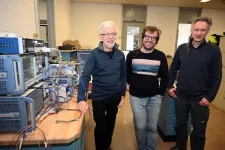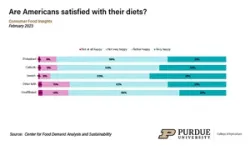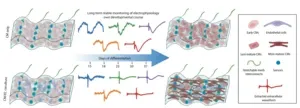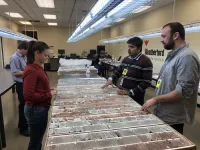(Press-News.org) UPTON, NY—Scientists at the U.S. Department of Energy’s (DOE) Brookhaven National Laboratory are leading a new effort to land a radio telescope on the moon. If successful, the project will mark the first step towards exploring the Dark Ages of the universe.
The Dark Ages are an early era of cosmological history starting about 380,000 years after the Big Bang. There were no stars or planets in the Dark Ages. It’s a point in time that scientists have never been able to observe. Though radio waves from the Dark Ages still linger in space, the abundance of radio interference on Earth has masked these signals from scientists seeking to study them.
If cosmologists could detect radio waves from the Dark Ages—what is known as the “Dark Ages Signal”—they could help uncover answers to some of the universe’s biggest mysteries, such as the nature of dark energy or the formation of the universe itself.
“Modeling the universe is easier before stars have formed. We can calculate almost everything exactly,” said Brookhaven physicist Anže Slosar. “So far, we can only make predictions about earlier stages of the universe using a benchmark called the cosmic microwave background. The Dark Ages Signal would provide a new benchmark. And if predictions based on each benchmark don’t match, that means we’ve discovered new physics.”
Now, a new project called the Lunar Surface Electromagnetics Experiment-Night (LuSEE-Night) aims to access the Dark Ages Signal for the first time. LuSEE-Night is a remarkable concept for a radio telescope that will be developed in collaboration between NASA and DOE, with Brookhaven Lab leading DOE’s role in the project and DOE’s Lawrence Berkeley National Lab providing key technical support.
LuSEE-Night is set to make history for its ability to reach—and survive in—an inhospitable place where there’s enough radio silence for the Dark Ages Signal to be detected: the lunar far side.
Surviving the Dark Side of the Moon
Some may know it as the “dark side of the moon,” but what is scientifically known as “the lunar far side” isn’t eternally dark. The lunar far side is named for its inability to be seen from Earth, but it experiences its own day and night cycle.
“The moon and Earth are tidally locked, which means that the moon rotates around its own axis with the same velocity as it does around the Earth,” said Slosar, who is leading DOE’s contributions to LuSEE-Night’s science program and operations and is also the LuSEE-Night collaboration spokesperson. “This is why we always see the same side of the moon. But the side we can’t see, the lunar far side, is shielded from many sources of radio interference at night by the moon’s own mass.”
Cosmologists around the world have been interested in observing the universe from the lunar far side for decades and they have attempted to reach it before. But in exchange for the radio silence the lunar far side provides, it presents a treacherous environment with little chance for scientific equipment to survive—let alone transmit data back to Earth.
The lunar far side is in total darkness for 14 Earth days followed by 14 days of brutal sunlight. That causes temperatures to fluctuate between 250 and -280 degrees Fahrenheit—and a dramatic change can happen in a matter of hours.
“The moon is easier to reach than Mars, but everything else is more challenging,” said Paul O’Connor, a senior scientist in Brookhaven’s Instrumentation Division and LuSEE-Night Project Instrument Scientist. “There's a reason only one robotic rover has landed on the Moon in the last 50 years, while six went to Mars, which is 100 times farther away. It’s a vacuum environment, which makes removing heat difficult, and there’s a bunch of radiation.”
LuSEE-Night must reject heat in a vacuum environment during the day and keep itself from freezing at night—all while powering itself through 14 days of continuous darkness and conducting first-of-its-kind science.
“The power has to come from a battery, which can only be so efficient based on its size,” O’Connor said. “More powerful batteries are heavier, and a flight mission to the moon has a strict mass limit. We have to be very parsimonious with the power that we allocate, and it puts us in a familiar domain where we must make trade-offs between power and sensitivity.”
Brookhaven’s Expertise Leads the Way
Building world-leading scientific instrumentation under strict design requirements is a longstanding area of expertise for Brookhaven Lab’s Instrumentation Division.
“We have a long history of building detector instrumentation that reaches the ultimate limits of sensitivity, whether that be for detecting subatomic particles in high energy physics experiments or ultrabright x-rays at the National Synchrotron Light Source II,” O’Connor said. “Over the last 15 years we’ve moved toward more astrophysics applications. Most notably, Brookhaven developed the 3.2 gigapixel sensor array for the Rubin Observatory. It is the biggest charge-coupled device (CCD) array that has ever been built.”
Brookhaven’s leadership role in the LuSEE-Night project also brings expertise in radio cosmology. In particular, the Lab has previously demonstrated the ability to design, construct, and operate a prototype radio telescope. Physicists, engineers, and technicians from the Lab’s Instrumentation Division and Physics Department collaborated to create the prototype and observe large swaths of the distant cosmos with high sensitivity.
The Lab’s scientific and technical expertise is a critical combination for achieving LuSEE-Night’s ambitious science goals and design requirements—particularly for developing highly sensitive radio telescopes.
“LuSEE-Night is not a standard radio telescope,” Slosar said. “It’s more of a radio receiver. It will work like an FM radio, picking up radio signals in a similar frequency band. The spectrometer is at the heart of it. Like a radio tuner, it can separate out radiofrequencies, and it turns signals into spectra. That’s where our expertise gives us a starting point. Even though nobody has built an instrument like this before, we know how to build the most crucial component—a very sensitive spectrometer.”
In addition to building the all-important spectrometer, Brookhaven is leading the DOE effort to construct the whole telescope.
“We will build out LuSEE-Night’s electronics, procure the batteries, solar panels, and communications equipment, and ensure all components of the instrument are cohesive and suited for spaceflight,” said Brookhaven scientist Sven Herrmann, the LuSEE-Night Construction Project Manager for DOE’s part of the mission and a researcher at the Kavli Institute for Particle Astrophysics and Cosmology. “We will handle the inner equipment assembly, then ship the pieces to UC Berkeley’s Space Sciences Laboratory for end integration. NASA will coordinate the launch through its Commercial Lunar Payload Services program, which leverages private companies to provide the transport to the moon .”
After touching down on the lunar far side, LuSEE-Night’s lander will turn off permanently so it does not produce any interference. The telescope will then deploy four three-meter-long antennas, developed by Berkeley Lab, on a turntable for data collection. Then, LuSEE-Night must face its greatest challenge: surviving its first night on the lunar far side.
At home on Earth, scientists must patiently wait 40 days for LuSEE-Night to collect and transmit its first dataset to a relay satellite that talks to Earth. Until then, they won’t know if LuSEE-Night survived.
If LuSEE-Night does survive, the collaboration will achieve its main goal: to prove that the long-sought lunar far side is accessible for radio cosmology experiments. Scientists will then have a proof-of-concept for developing a more elaborate telescope in the future that is better equipped to detect the distant Dark Ages Signal—if it’s needed.
While LuSEE-Night is primarily considered a pathfinder, it is designed to collect data for two years and magnificent discoveries are possible. LuSEE-Night could exceed its main goal and detect the Dark Ages Signal on its own, or even uncover new and unexpected mysteries hidden deep in the cosmos along the way.
Brookhaven National Laboratory is supported by the Office of Science of the U.S. Department of Energy. The Office of Science is the single largest supporter of basic research in the physical sciences in the United States and is working to address some of the most pressing challenges of our time. For more information, visit science.energy.gov.
Follow @BrookhavenLab on Twitter or find us on Facebook.
END
Lunar telescope will search for ancient radio waves
DOE and NASA are collaborating to land a radio telescope on the far side of the moon and probe an unexplored era of the early universe
2023-03-08
ELSE PRESS RELEASES FROM THIS DATE:
How a metabolite causes inflammation and disease
2023-03-08
A new study shows for the first time a connection between a mitochondrial metabolite and the activation of an inflammatory response. Mitochondria are functional units of our cells that fulfil important tasks, i.e. chemical reactions, for the functioning of the cell. One of these tasks is the production of energy that is necessary for cell growth and reproduction. If certain chemical reactions in the mitochondrion change, diseases occur. For example, deficiencies in fumarate hydratase (FH) in the Krebs cycle, one of the most important metabolic pathways in mitochondria, ...
'Other' race/ethnicity linked to higher suicide and overdose risk in military members with mild TBI
2023-03-08
March 8, 2023 – Previous studies have reported high rates of death by suicide and drug overdose – including opioid overdose – in military service members with a history of mild traumatic brain injury (mTBI). A new study finds that those risks are highest among military members with mTBI who identify their racial/ethnic status as "Other," as opposed to standard racial/ethnic categories, reports the March/April issue of the Journal of Head Trauma Rehabilitation (JHTR). The official journal of the Brain Injury Association of America, JHTR is ...
Cancer Grand Challenges announces global research funding opportunity with nine new challenges
2023-03-08
The National Cancer Institute (NCI), part of the National Institutes of Health, and Cancer Research UK have announced nine new research challenges aimed at tackling some of the most profound problems in cancer research. The global funding opportunity is part of the Cancer Grand Challenges program, an initiative launched by NCI and Cancer Research UK in 2020.
The research initiative aims to inspire bold new ideas that have the greatest potential for advancing cancer research and improving outcomes for people affected by cancer. The new round of challenges, announced March 8, 2023, during the Cancer Grand Challenges Annual Scientific Summit in London, is open until June ...
Genes in beans! Bean genome sequenced for improved nutrition
2023-03-08
The faba bean genome, which at 13 billion bases is more than four times the size of the human genome, has been sequenced for the first time and is published today (08 March 2023), in Nature. This is an extraordinary technical achievement and crucial to efforts to breed beans with optimum nutritional content and sustainability of production.
A consortium of scientists from Europe and Australia, led by the University of Reading (UK), Aarhus University (Denmark) and the University of Helsinki (Finland), worked together on this large scale sequencing project.
The project to fully decode the genome went on to test out its usefulness by searching for genes involved ...
MD Anderson research highlights for March 8, 2023
2023-03-08
HOUSTON ― The University of Texas MD Anderson Cancer Center’s Research Highlights showcases the latest breakthroughs in cancer care, research and prevention. These advances are made possible through seamless collaboration between MD Anderson’s world-leading clinicians and scientists, bringing discoveries from the lab to the clinic and back.
Recent developments include overlooked proteins from long noncoding RNAs that likely play a functional role in breast cancer, inhibiting tumor-associated neuronal cells to improve treatment response in pancreatic cancer, ...
Discovery of T cells’ role in Alzheimer’s, related diseases, suggests new treatment strategy
2023-03-08
Nearly two dozen experimental therapies targeting the immune system are in clinical trials for Alzheimer’s disease, a reflection of the growing recognition that immune processes play a key role in driving the brain damage that leads to confusion, memory loss and other debilitating symptoms.
Many of the immunity-focused Alzheimer’s drugs under development are aimed at microglia, the brain’s resident immune cells, which can injure brain tissue if they’re activated at the wrong time or in the wrong way. A new study from researchers at Washington University School of Medicine in St. Louis ...
Newborn drug testing by race, ethnicity before and after recreational cannabis legalization
2023-03-08
About The Study: Researchers found in this examination of newborn drug testing at a Midwestern academic medical center before and after statewide legalization of recreational cannabis that clinicians ordered newborn drug tests more frequently for Black newborns when no drug testing was done during pregnancy. These findings call for further exploration of how structural and institutional racism contribute to disproportionate testing and subsequent Child Protective Services investigation, surveillance, and criminalization of Black parents.
Authors: Lauren Oshman, M.D., M.P.H., of the University of Michigan ...
Major North American oil source yields clues to one of earth’s deadliest mass extinctions
2023-03-08
The Bakken Shale Formation—a 200,000-square-mile shale deposit below parts of Canada and North Dakota—has supplied billions of barrels of oil and natural gas to North America for 70 years. A new discovery reveals that the rocks also open a uniquely informative window into Earth’s complicated geological history.
A research team, which included geologists from the University of Maryland, George Mason University and the Norwegian oil and gas company Equinor, developed a new framework for analyzing paleontological and biogeochemical data extracted from the formation’s rock. Using this technique, the team pinpointed a major trigger of several closely spaced ...
Study reveals new understanding of how androgen therapy affects breast tissue
2023-03-08
New insights into the effects of a hormonal treatment for transgender men, discovered by Cedars-Sinai investigators, could have implications for the treatment of breast cancer.
Transgender men who were assigned female at birth and identify today as male may take hormones called androgens to induce physical changes that help them align their physical appearance with their identified gender. Androgens such as testosterone are involved primarily in the development of male traits, although females also produce androgens.
Molecular changes observed in the breast tissue of transgender men undergoing androgen therapy may signal the potential ...
How the Brain Senses Infection
2023-03-08
At a glance:
A small population of airway neurons alerts the brain about a flu infection, according to a new study in mice
The results help explain how drugs like ibuprofen and aspirin reduce flu symptoms
The findings could help scientists develop more-effective flu therapies
A new study led by researchers at Harvard Medical School illuminates how the brain becomes aware that there is an infection in the body.
Studying mice, the team discovered that a small group of neurons in the airway plays a pivotal role in alerting the brain about ...
LAST 30 PRESS RELEASES:
Ants: An untapped resource in the development of antibiotics?
Archaeologists use AI to create prehistoric video game
Mitochondria migrate toward the cell membrane in response to high glucose levels
Tiny viral switch offers hope against drug-resistant bacteria
Most parents aware of early peanut introduction guidelines, but confused about details
HPV vaccine can protect against severe lesions of the vulva and vagina
Virtual care provision and emergency department use among children and youth
Quadrivalent HPV vaccine and high-grade vulvovaginal lesions
Insights into dry eyes gained from stem cell-derived tear glands
Researchers identify 166 human pluripotent stem cell lines available for use in clinical applications
Europa Clipper instrument uniquely observed interstellar comet 3I/ATLAS
UN University Report challenges climate change as sole trigger of Syrian Civil War, exposing governance failures in drought response
Real estate investment trust (REIT) acquisition associated with hospital closure and bankruptcy
New Raman imaging system detects subtle tumor signals
Boston Children’s receives a $7.5 million grant from Aligning Research to Impact Autism (ARIA) to provide clinical research coordination for the IMPACT Network
Spray-on antibacterial coating offers new protection for plants against disease and drought
ESMT Berlin study: What makes a first offer successful in negotiations
Groundbreaking ceremony marks the beginning of CTAO-South Array construction in Chile
Why swearing makes you stronger
What prevents more cancer patients from enrolling in potentially life-saving clinical trials?
UK’s worst-case climate risks laid bare for lawmakers
A decline in churchgoing linked to more deaths of despair
TAMEST announces Maralice Conacci-Sorrell, Ph.D., UT Southwestern Medical Center, as 2026 Mary Beth Maddox Award & Lectureship Recipient
Global study to evaluate whether dengue outbreaks can be anticipated earlier
Chonnam National University researchers propose innovative voltage-loop control for power factor correction
Accelerating next-generation drug discovery with click-based construction of PROTACs
Detecting the hidden magnetism of altermagnets
$7M gift supports health research, engineering and athletics at UT San Antonio
NU-9 halts Alzheimer’s disease in animal model before symptoms begin
Hospitals acquired by real estate investment trusts associated with greater risk of bankruptcy, closure
[Press-News.org] Lunar telescope will search for ancient radio wavesDOE and NASA are collaborating to land a radio telescope on the far side of the moon and probe an unexplored era of the early universe




